Flood and hail warnings have been issued in Spain as a popular holiday hotspot is deluged – while Britain basks in the sun.
A whopping half of the country’s 50 provinces have received weather warnings from the State Meteorological Agency (AEMET).
Eight of those face a higher orange alert, the second highest, as of today – so locals and tourists there should prepare for severe storms, extreme rain and flash floods.
These regions set to face a heavy battering are Huesca, Teruel, Zaragoza, Barcelona, Girona, Lleida, Tarragona and Castellon, The Sun reports.
The effects are already being felt across the country, with shocking pictures showing cars submerged and swept away, with streets totally flooded by strong currents.
One popular tourist destination, the town of Tarazona in Zaragoza, has already seen 100mm of rainfall in just one hour, on Friday – and remains on red alert today.
Meanwhile, Britain’s heatwave was expected to peak today, with sizzling highs of 35C possible in parts of the UK.
The extreme weather in Spain threatens huge damage to neighbourhoods, as well as disruption to Brits holidaying all over the country in hope of some Spanish sun.
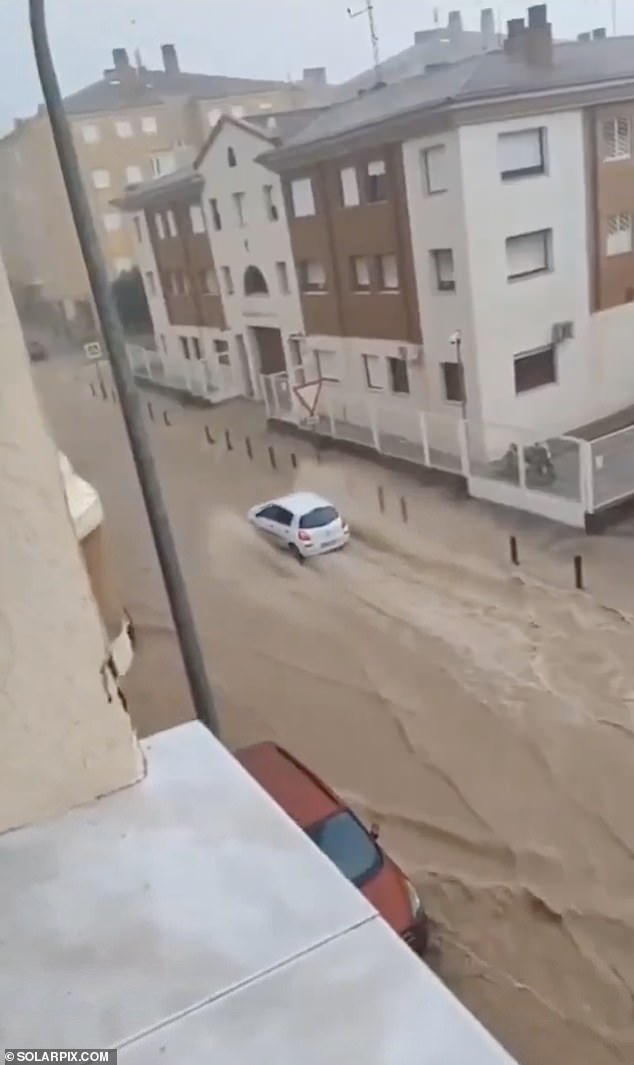
Flood and hail warnings have been issued in Spain as a popular holiday hotspot is deluged – while Britain basks in the sun
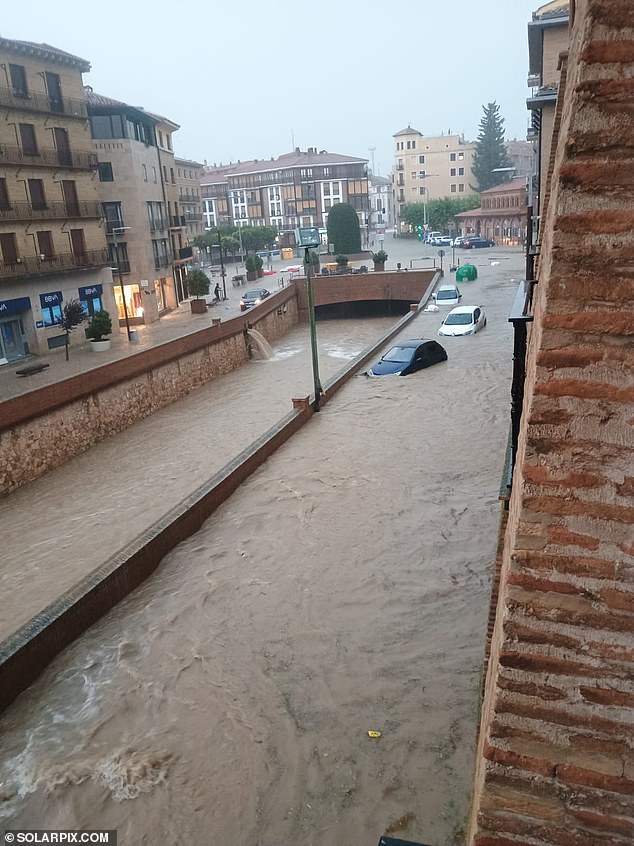
A whopping half of the country’s 50 provinces have received weather warnings from the State Meteorological Agency (AEMET)
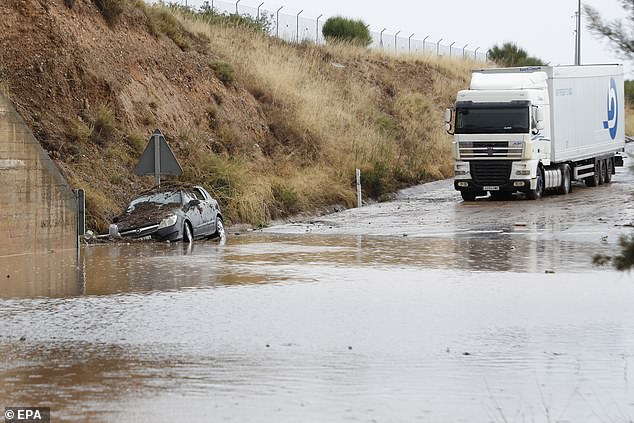
Eight of those face a higher orange alert, the second highest, as of today – so locals and tourists there should prepare for severe storms, extreme rain and flash floods
The downpour in Tarazona caused street flooding, heavy disruption to public transport and brutal damage to property in the getaway hotspot.
The Military Emergency Unit (UME) – the branch of the army responsible for national disaster or emergency relief – has been deployed across the province to help.
Rescue teams in Zaragoza have reported more than 30 flood-related incident, including blocked roads and fallen trees – but luckily, no casualties.
Rainfall of up to 50 litres per square metre has been predicted in most parts of Aragon and Catalonia – which could cause flooding and even overflowing ravines.
The worst affected areas will be Catalonia, Aragon and the Valencian Community, where intense rain had been predicted to begin early today.
In fact, the Catalan weather service Meteocat has issued its own highest possible weather warning, at levels five and six, according to Catalan News.
It marks a serious deterioration in weather conditions in the province, replacing previous orange and yellow warnings.
All residents in the area will receive a mobile phone notification to alert them to the heavy storms coming their way, which are expected to last until at least 9pm today.
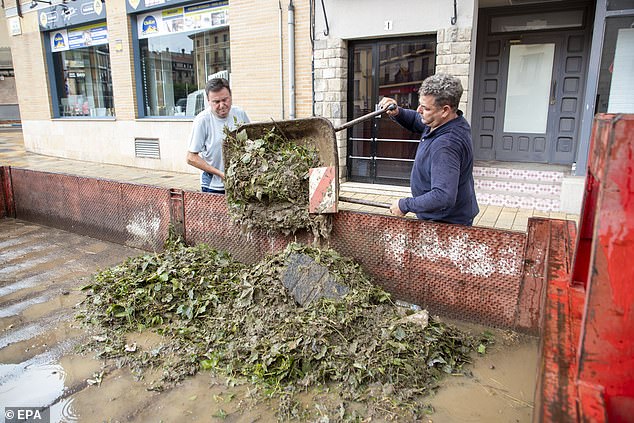
The downpour in Tarazona caused street flooding, heavy disruption to public transport and brutal damage to property in the getaway hotspot. Pictured: Residents remove leaves that clogged up drains after the heavy rain in Tarazona on Saturday
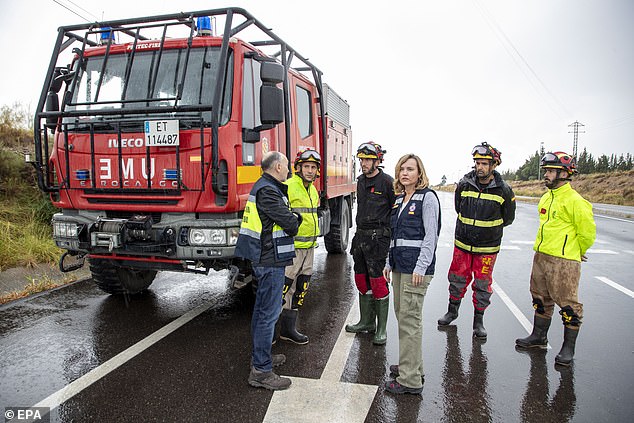
The Military Emergency Unit (UME) – the branch of the army responsible for national disaster or emergency relief – has been deployed across the province to help. Pictured: Spanish Education Minister PIlar Alegria meets the UME in Aragon on Saturday
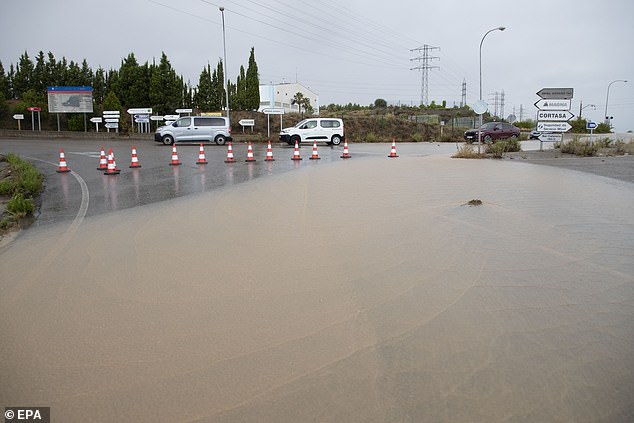
Rescue teams in Zaragoza have reported more than 30 flood-related incident, including blocked roads and fallen trees – but luckily, no casualties. Pictured: Flooding in Aragon on Saturday
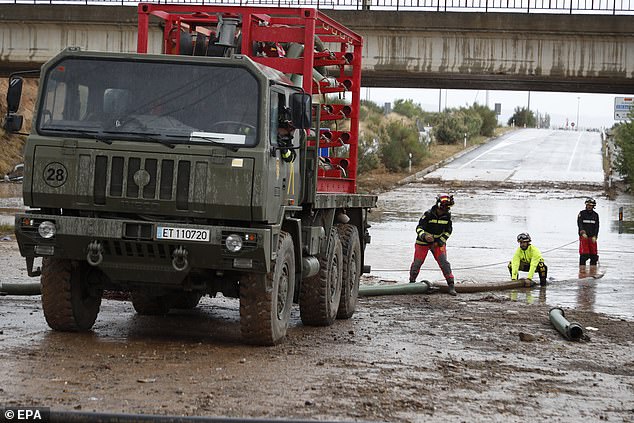
Rainfall of up to 50 litres per square metre has been predicted in most parts of Aragon and Catalonia – which could cause flooding and even overflowing ravines. Pictured: The UME work on a flooded road in Aragon on Saturday
After rain began last night, authorities received a huge 70 reports of minor weather-related incidents.
And they have advised the public to avoid travel and stay indoors and away from rivers and flood-risk areas.
Some areas in Catalonia could see up to 40 litres of rain per square metre, which could cause flooding.
Later today, storms were expected to hit the Cantabrian coast, the Balearic Islands and areas of central and eastern Spain.
Storm warnings are set to hit other regions too, including Alicante, Valencia, Alava and the Ribera del Ebro area of La Rioja, among others.
Meanwhile, the mercury has hit record-breaking highs back in Blighty.
Temperatures reached 34.7C at Astwood Bank, near Worcester, on Friday, the Met Office said, with similar or even higher temperatures having been expected today.
‘It might be plus or minus half a degree higher or lower (on Saturday), probably maybe a little bit higher, but that’s going to be the peak as then temperatures start coming down a little bit through the second half of the weekend as low pressure slowly starts to edge in,’ meteorologist Greg Dewhurst said.
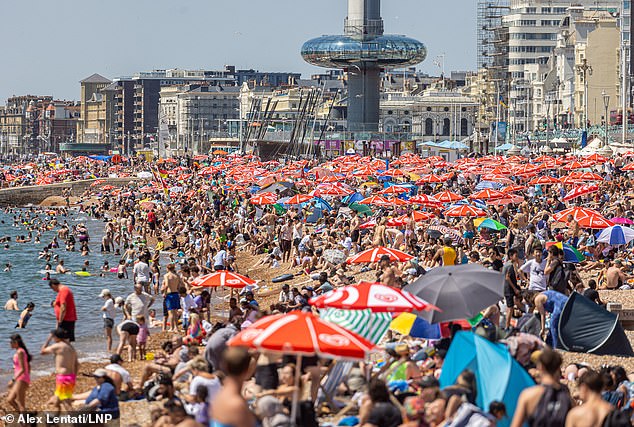
Meanwhile, the mercury has hit record-breaking highs back in Blighty. Pictured: Brighton Beach on Saturday
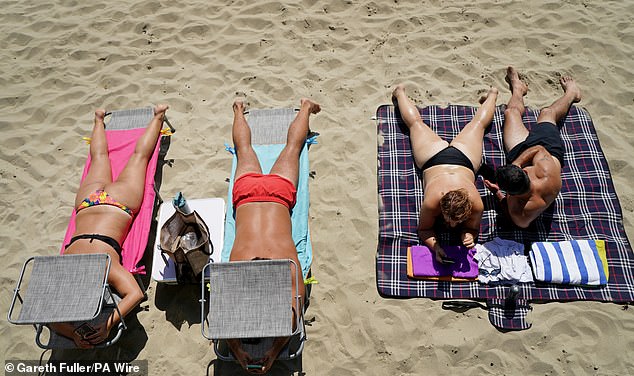
Temperatures reached 34.7C at Astwood Bank, near Worcester, on Friday, the Met Office said, with similar or even higher temperatures having been expected today. Pictured: Sunny Sands beach in Folkestone, Kent, on Friday

Six million homes have been hit with a hosepipe ban, while fire chiefs warn of the risk of wildfires and drowning as people try to escape the heat in pools and ponds. Pictured: Clevedon Marine Lake in Somerset on Friday
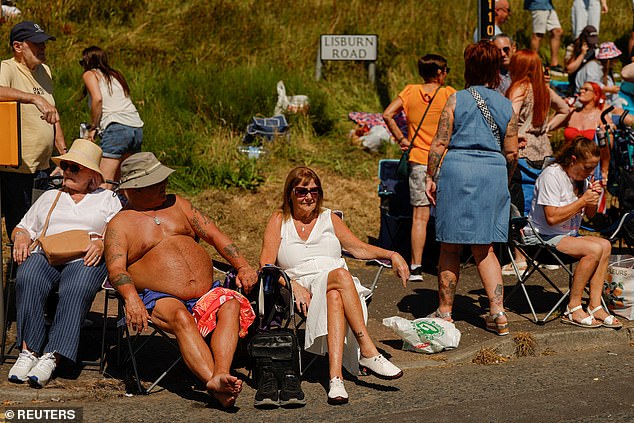
Amber heat health alerts are in place for the Midlands and the south and east of England until 9am on Monday. Pictured: Spectators at the Twelfth of July parade in Belfast on Saturday
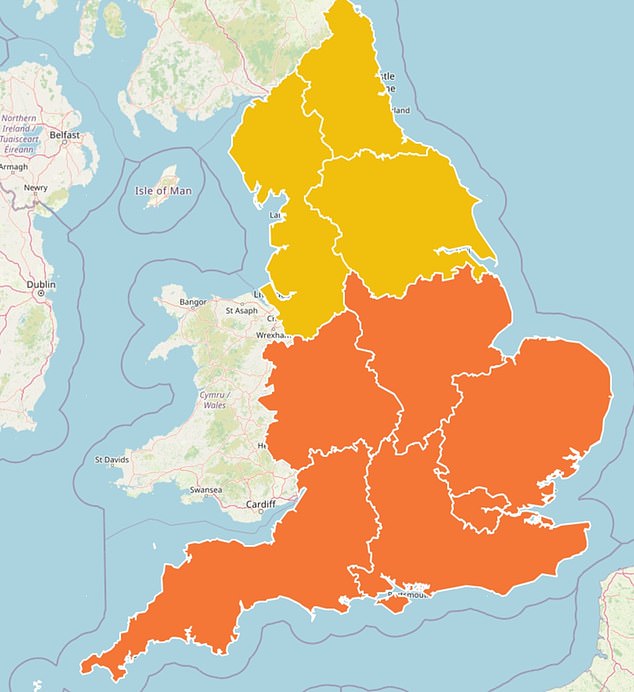
They warn of the potential for a rise in deaths, particularly among those aged 65 and over or with health conditions
Six million homes have been hit with a hosepipe ban, while fire chiefs warn of the risk of wildfires and drowning as people try to escape the heat in pools and ponds.
Amber heat health alerts are in place for the Midlands and the south and east of England until 9am on Monday.
They warn of the potential for a rise in deaths, particularly among those aged 65 and over or with health conditions.
The risk of wildfires in London is currently rated at ‘severe’ by the Natural Hazards Partnership.
And National Rail has also warned train passengers that the hot weather may cause disruption this weekend.
The Met Office said though temperatures may peak on Saturday, it will remain ‘very warm’ across the country on Sunday.
‘We’re probably looking at maximum temperatures around 30C, 31C degrees across central and southern England, but still widely across the whole UK, mid to high 20s,’ Mr Dewhurst said.
‘It could still get to around 29 or 30C across southeast England on Monday, and then everyone into the fresher air by Tuesday, temperatures more like 23C, 24C as the maximum temperature.’
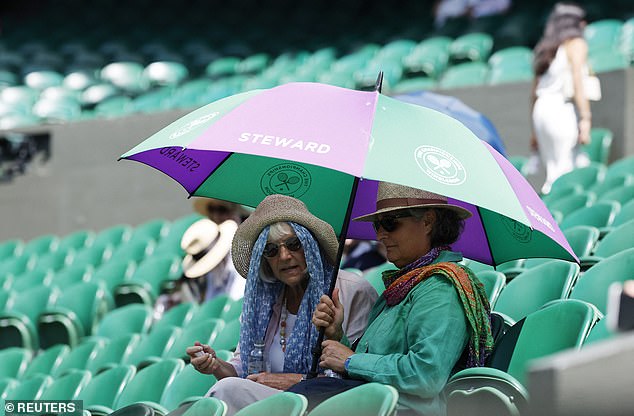
The risk of wildfires in London is currently rated at ‘severe’ by the Natural Hazards Partnership. Pictured: Spectators at Wimbledon on Saturday

National Rail has also warned train passengers that the hot weather may cause disruption this weekend. Pictured: Attendees at the Bristol Pride festival on Saturday

The Met Office said though temperatures may peak on Saturday, it will remain ‘very warm’ across the country on Sunday. Pictured: A father and son at Lord Cricket’s Ground on Saturday

As well as the amber alerts, the UK Health Security Agency (UKHSA) has yellow alerts in place until Monday for the North East, North West and Yorkshire and Humber. Pictured: A sunbather in London’s Vauxhall Park on Saturday
As well as the amber alerts, the UK Health Security Agency (UKHSA) has yellow alerts in place until Monday for the North East, North West and Yorkshire and Humber.
Fortunately, in Spain, the rainy, stormy conditions are expected to clear overnight.
And while parts of the country are pummelled by rain, southeastern Spain will remain sizzling hot, perhaps even hitting record highs.
The mercury could approach or even increase beyond a tropical 40C in Murcia, Alicante, inland Andalusia and parts of Extremadura.
Temperatures will soon then drop across vast swathes of the mainland and Canary Islands.
The islands, along with the Alboran coast, will then be hit by high, potentially very strong winds.
The storms come as part of a so-called DANA storm, a Spanish acronym standing for ‘depresion aislada en niveles altos’, meaning ‘isolated depression at high altitudes’.
These conditions are brought about when more warm, moist Mediterranean air is sucked into high levels of the atmosphere than normal.
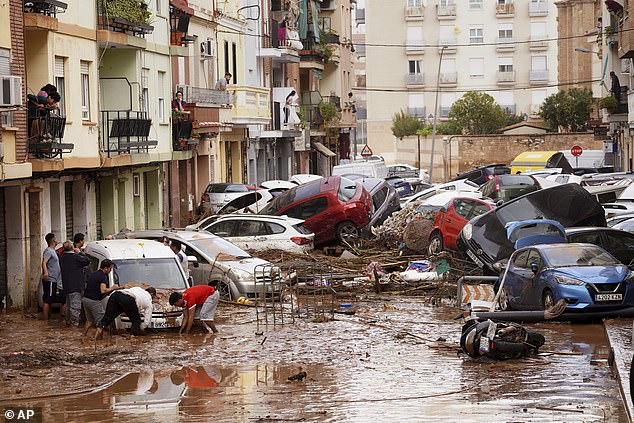
A DANA was behind the flooding in Valencia in October last year (pictured), in which nearly 230 people tragically died, in one of Spain’s worst weather disasters in recent years
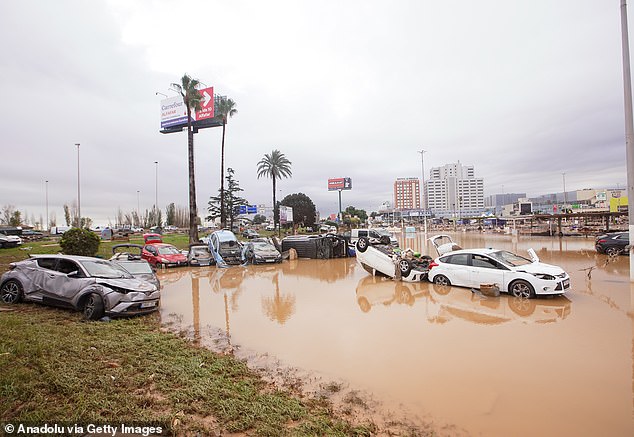
The floods turned streets in the Spanish city into rivers (pictured) and left hundreds trapped in their homes
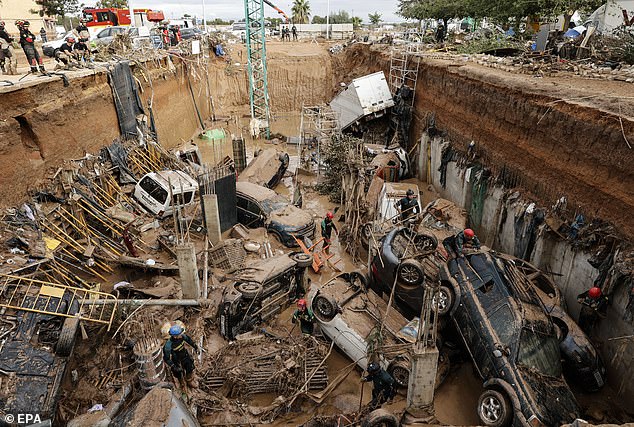
Many were forced to climb trees, scale lampposts and sprint desperately to the upper floors of buildings to escape. Pictured: Cars trapped under the foundations of a building under construction in Valencia during flooding there at the end of last year
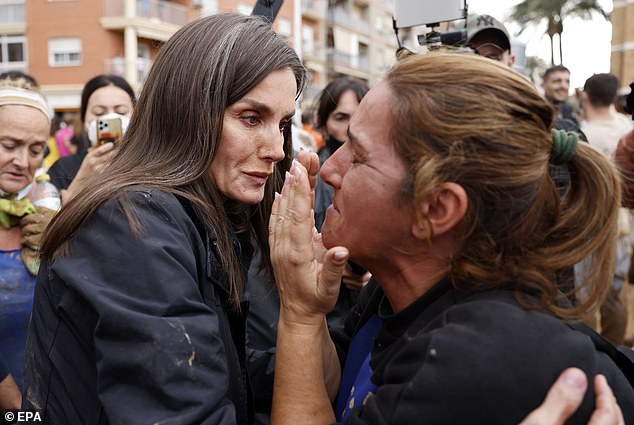
Shocking footage emerged showing how parts of Valencia became completely engulfed by deadly flash floods that appeared from nowhere. Pictured: Spain’s Queen Letizia consoles a woman during her visit to Paiporta, eastern Spain, on November 3, 2024
It can cause severe weather like lightning, hail or even tornadoes – and sudden shifts in conditions, bringing often highly concentrated bursts of rain or storms in minutes.
Unstable air is moving across the Iberian Peninsula to the north and east, bringing on the thunder and heavy rainfall.
A DANA was behind the flooding in Valencia in October last year, in which nearly 230 people tragically died, in one of Spain’s worst weather disasters in recent years.
The floods turned streets in the Spanish city into rivers and left hundreds trapped in their homes.
Many were forced to climb trees, scale lampposts and sprint desperately to the upper floors of buildings to escape.
Shocking footage emerged showing how parts of Valencia became completely engulfed by deadly flash floods that appeared from nowhere.
Torrents of water were seen tearing through towns and infrastructure, sweeping cars down roads, submerging fields in mud and trapping people in basements and cars.
It made the disaster the worst floods to hit a single European country this century.












